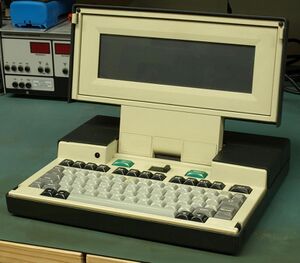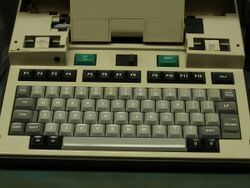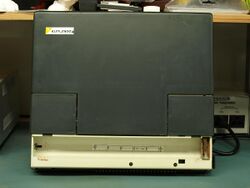Engineering:Dulmont Magnum
 Dulmont Magnum | |
| Also known as | Kookaburra |
|---|---|
| Developer | Dulmison Pty Ltd[2] |
| Manufacturer | Dulmont Electronic Systems Pty Ltd[3] |
| Type | Portable computer |
| Discontinued | 1986[4] |
| Operating system | MS-DOS 2.11[5] |
| CPU | 8-MHz Intel 80186[6][7] |
| Memory | 96KB-384KB RAM, 128KB-384KB ROM |
| Storage | Optionally External Dual 5.25" floppy disk drives, or an external 10 MB hard drive |
| Removable storage | Dual 128K ROM cartridge slots |
| Display | 8 lines, 80 characters LCD screen (1982–1983) 16 lines, 80 characters LCD screen (1984–1985 international release) 25 lines, 80 characters LCD screen (1985-6 final version) Earlier versions were able to be upgraded to the larger displays. |
| Input | 76-key Keyboard |
| Power | Battery External mains power |
| Dimensions | 32 x 27.5 x 5.5cm |
| Mass | 4.8kg |
The Dulmont Magnum[1] is an early laptop computer designed initially by Australian power line equipment manufacturer Dulmison Pty Ltd and subsequently marketed by Dulmont Pty Ltd.[2] Exhibited in September 1983,[8] it was the world's first true battery-powered laptop computer.
Dulmont was a joint venture between Dulmison and an Australian subsidiary of their electrical utility customer the Belgian National Electricity Authority, Tramont Ltd.[9]:285–6 The Magnum was sold from 1983 to 1986. The company found itself undercapitalized as it sought to enter the international market and faced increased competition from other laptops. It was taken over twice, with Dulmont eventually taken over in 1984 by Time Office Computers (Manufacturing) Pty. Ltd.[10]
Development and promotion
The initial concept was hatched in 1981 by Clive Mackness. He was then no. 2 to owner Philip Dulhunty at Dulmison and assigned Dulmison freelancing engineer David Irwin the task of designing a product. Terry Crews and others were brought into the team that spent the first months on feasibility.[11][9]:285
John Blair led the software engineering team.[12][13][9]:285 Development dragged on and the project was in danger of folding due to Dulmison's limited financial resources but was revitalised when Mackness secured a A$800,000 federal government grant.[11]
The Magnum was to have been enabled by a custom power management integrated circuit that was to be developed in the VLSI and Systems Technology Laboratory at the University of New South Wales (UNSW) over 4 months in early 1982 by Graham Hellestrand. The ~10,000 transistor, 5μ nMOS technology chip, however, never saw the light of day.
Terry Crews was the initial Engineering Manager and contracted Barry Wilkinson to design the hardware based on discrete components as he had doubts about the custom chip. The form factor and cosmetic design was developed first and this then dictated the physical dimensions of the hardware. This was in contrast to the usual method of encasing the electronics as the last process and their subsequent bulkier designs.
The Dulmont joint venture having been formed in 1982 and with the benefit of a cash injection of about A$1.5 million from Tramont,[11] the Magnum went into production, Crews became Marketing Manager and the hardware engineering role was taken over by Chris Todter. Crews traveled the world showcasing the product. It attracted substantial interest and some large orders. The Magnum was marketed in Australia from 1983 to early 1986, thus being developed and launched prior to the development of the Grid Compass.
The Magnum was launched publicly at the 10th Australian Computer Conference on same day that Australia won the America's Cup in September 1983.[8]
Design and features
The Magnum was one of the first computers to use the 16-bit Intel 80186 processor, and was sold in versions with 96K to 256K of RAM, and inbuilt LCD screens from 8x80 to 25x80 characters. It had a word processor, spreadsheet, telecommunications, file manager, and appointment programs burned into ROM. It also featured dual 128K ROM cartridge slots, which could be used for optional software including BASIC or assembler programming support, as well as serial and parallel modem and printer ports. The 1982 to 1983 prerelease and initial release versions included an 8x80 character LCD screen, whilst the 1984 to 1985 international release[14][15] had a 16x80 display, and the final 1985-6 version had a 25x80 display and for international marketing purposes was given the new name "Kookaburra". Earlier versions were able to be upgraded to the larger displays, and a dual 5.25" floppy drive and memory expansion box provided access to up to 256KB of dynamic RAM. Applications were stored in ROM (A:) and also supported removable modules in expansion slots (B: and C:) that could be custom programmed EPROM or standard word processing and spreadsheet applications. The Magnum could suspend and retain memory in CMOS battery-backed RAM (RAM Disk D:). There was even an expansion box providing 10MB of hard disk storage.[citation needed]
In 1985, the Magnum retailed for 2995 AU$ (today $8649.05) for a 96K model, or 4100 AU$ (today $11840.1) for a 256K model.[citation needed].
Demise
Dulmont, a complete newcomer to electronics, let alone computer, manufacturing, suffered numerous production problems. The product had endemic faults and deliveries were delayed. The reputation of the product went from enthusiastic anticipation to disappointment.[11]
The Magnum laptop computer was similar to the Hewlett-Packard HP 110 and the Sharp PC-5000 and is the only Australian produced laptop personal computer, but did not survive long on the international market once industry players like HP, Sharp and Sanyo entered the market. One key disadvantage of both the Dulmont Magnum [Kookaburra] and the Grid Compass is that they were developed prior to the IBM PC and were never upgraded to full IBM compatibility, using an early version of MS-DOS (latest version used was 2.11).[5] A second disadvantage of the Magnum was the lack of integral permanent storage other than the ROM/EPROM that was available through the module cartridge slots,[clarification needed] or the separate expansion box. In particular, its soon-to-arrive competitors (including the Grid Compass) made use of the new bubble memory technology to provide non-volatile memory.
References
- ↑ Jump up to: 1.0 1.1 Name:DULMONT MAGNUM / Registered state/no. NSW H6207808 / Type: Business Names /Date Deregistered: 21/08/1986 / Jurisdiction: Office of Fair Trading, New South Wales, Australia , Dulmont Magnum registered business name, Australian Securities & Investments Commission search
- ↑ Jump up to: 2.0 2.1 Dulmison Pty Ltd - designer of the Dulmon Magnum , Australian Securities & Investments Commission search
- ↑ "BIOGRAPHY – Dr. Graham Hellestrand". July 2012. https://www.academia.edu/attachments/24867522/download_file.
- ↑ "COMPUTERS AND TECHNOLOGY Laptops for the artist, or the artisan.". The Canberra Times: p. 12. 23 November 1987. http://nla.gov.au/nla.news-article122117272. Retrieved 13 April 2015.
- ↑ Jump up to: 5.0 5.1 MICROBYTES: Two MS-DOS Portable computers enhanced, Page 10, BYTE Vol 10-08 1985–08 The Amiga
- ↑ Dulmont Magnum, OLD-COMPUTERS.COM Museum
- ↑ "Advertising.". The Canberra Times: p. 8. 5 November 1983. http://nla.gov.au/nla.news-article116393780. Retrieved 13 April 2015.
- ↑ Jump up to: 8.0 8.1 Cite error: Invalid
<ref>tag; no text was provided for refs namedaulaunch1983 - ↑ Jump up to: 9.0 9.1 9.2 Dunhunty, Philip (2009). Never a Dull Moment. Philip Dulhunty.
- ↑ "Time borrows $1m to buy Dulmont.". The Canberra Times: p. 15. 22 October 1984. http://nla.gov.au/nla.news-article136923117. Retrieved 11 April 2015.
- ↑ Jump up to: 11.0 11.1 11.2 11.3 "The Story of Dulmont". Electronics Today International: 132. July 1985. https://archive.org/stream/ETIA1985/ETI%201985-07%20July_djvu.txt. Retrieved 12 January 2019.
- ↑ "John Blair: Executive Profile & Biography". Businessweek. https://www.bloomberg.com/research/stocks/private/person.asp?personId=817184&privcapId=3095585.
- ↑ "Puredepth_8k-012308.HTM". https://www.sec.gov/Archives/edgar/data/1281108/000126645408000045/puredepth_8k-012308.htm.
- ↑ 2007/49/1 Dulmont Magnum laptop computer and accessories, plastic / metal / glass / electronic components, designed and made by Dulmont Electronic Systems Pty Ltd, Sydney, New South Wales, Australia, 1985, Powerhouse Museum Collection
- ↑ "Dulmont Magnum Portable Computer" (2002/5.1), Dulmont Electronic Systems Propriety Limited , Newcastle Regional Museum.
External links
- Dulmont Magnum - the first Aussie micro (evaluation), By John Anderson., CREATIVE COMPUTING VOL. 11, NO. 1 / JANUARY 1985 / PAGE 58
- "Dulmont Magnum, 360 degree model", Vintage Laptop Museum, 5 April 2017, http://vintage-laptops.com/?page_id=50&lang=en.
- Genius versus bricks-and-mortar in the head (Publisher: The Australian. By STEVE KEEN. JUNE 9, 2014. News on "Vixtel Unity" crowdfunding project.)







